I hope this interview will give you additional insight to the interesting online interviews by Dean Esmay and John Little.
EGO: First of all, I want to thank you very much for your work with the EGO logotype. Do you want to tell my readers how you came up with the logotype?
FORKUM: The initial idea for the logo was a graphic solution using the word "ego" to form a person's face, but the results didn't really connote egoism strongly enough. I knew John could illustrate a heroic, proud man so that is the tack we took. The original drawing had a square border around it. We eliminated that so the man would be the highest graphic element in the logo. The sphere was meant to connote a lofty peak or even the world itself.
COX: Heroic was what I was shooting for. There was power in his stance that I think captured a sense of joy and determination. I really wanted to work simple, simple, simple. You put the logo on a jersey and I've worn that shirt out. [EGO Editor: How about sending a X-mas gift to John & Allen?] I really liked the understated size of the artwork, yet its intent is a real attention-getter. That logo was a fun project.
EGO: Your first war cartoon, "Blend," was created on September 20, 2001. Please tell me your reactions to what happened on 9/11.
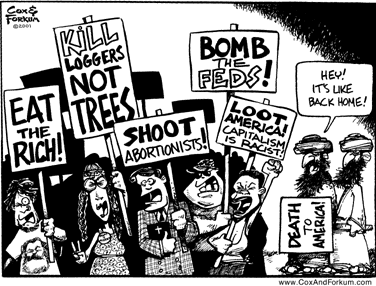
FORKUM: Disbelief, horror, fear, anger, grief ... and under all those feelings was a dismay at my own ignorance that such a threat even existed. Of course I knew that militant fundamentalist Muslims hated America and that they regularly attacked us overseas, from Lebanon to Africa to Yemen. I knew they had attack the WTC once before. I knew the Taliban had destroyed non-Islamic statues in Afghanistan. I recalled the name Osama bin Laden. But I never imagined Islamists' willingness and capacity to commit an atrocity on the scale of 9/11. It was a wake-up call for me, to better educate myself on the threat and how to defend ourselves against it. In particular I wanted to fight the battle against Islamist jihad ideology. That desire is fundamental to our editorial cartooning today.
COX: That day changed America. It changed me. How could it not? Now, all I want to do is take the fight to the horrific ideologies that fueled such anti-Americanism. We're editorial cartoonists, so the battlefield is there.
FORKUM: Along those lines, I elaborated about the "Blend" cartoon in our book: Islamic terrorists share an irrationalism with certain activists in America which results in a common bond -- a willingness to use force against those who disagree, a willingness to place their causes above individual rights.
EGO: I think that your cartoon, "Censorship, Berkeley-Style," is showing how the leftists of the academic world are trying to use dirty tricks as a method in order to stop the freedom of speech at universities. For a background, read my post, ANTI-REASON AT UC BERKELEY. Have you been in contact with many students through your blog?
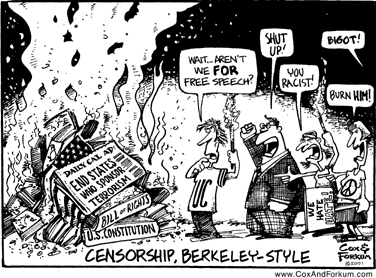
FORKUM: Yes, they've contacted us. University students have asked permission to use our cartoons on flyers advertising demonstrations and lectures. Some student newspapers have published our cartoons. The cartoon "Affirmative Racism" even caused somewhat of a controversy at Texas A&M. So there's definitely some interest there.
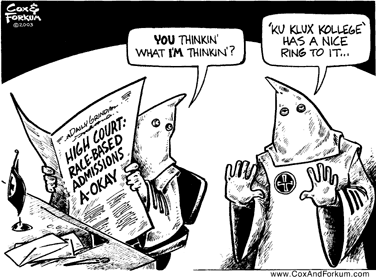
And I would add regarding the Berkeley cartoon that it also shows what many college leftists are in essence: intolerant, anti-free-speech thugs.
EGO: What's your favorite source and inspiration for new cartoons?
FORKUM: Mainly current events, though sometimes we "lead" by commenting on issues we think are important. I spend a lot of time checking the latest news online at CNN, FoxNews and Google News as well as surveying information in the blogosphere, which is abundant and useful. I often wish that I had more time just to keep up with the blogosphere. The op-eds at The Ayn Rand Institute are also inspiring.
EGO: What's your view on today's media?
FORKUM: My general view of them is pretty negative. There's seems to be a gross lack of objectivity that leads to biases of every sort, from editorializing in "news" articles to the total evasion of important events. Some of this may be laziness, some may be political sympathizing, and some may be out and out propagandizing. But whatever the reason, it is not good journalism. This is not to say that all journalists and every media outlet are corrupt in some way. I don't know enough to comment on the extent of the problem. But when you have major news organizations like Reuters that even after 9/11 refused to call terrorists "terrorists," it's an indication of deep problems.
EGO: During a panel discussion at the Oslo Objectivist Conference, one question was about the fact that several individuals have learned about Ayn Rand's books and philosophy, through listening to a rock group called Rush. Do you know if you have inspired some of your readers to check out literature by Ayn Rand?
FORKUM: Yes, a couple of people have mentioned to me that they've looked further into Objectivism, and I find that immensely rewarding even though it is not the primary purpose of our cartoons.
EGO: What kind of different feedback have you got from your readers?
FORKUM: The overwhelming majority of our feedback is positive, but we also regularly receive criticism, from the full political spectrum -- conservatives, libertarians and leftists.
COX: The biggest kick I get out of our work is opportunity to hear from folks so fast. I've stated it before, but the time between airing the work and hearing what fans think of the work is now down to virtually nothing, and I truly dig the vulnerability... laying it out there and experiencing the response.
EGO: It was very interesting to read the interview in TIA on how you developed an idea for a cartoon. You refer to Ayn Rand's book, The Art of Nonfiction. How have you been able to achieve such clarity in your style?
FORKUM: That's a tough question. It's partly a matter of practice. I used to write editorials for my own publications as well as write letters to editors of other newspapers. Effective op-eds and LTEs boil an issue down to its essence and comment on it concisely, often using analogies and metaphors to drive home a point. Creating cartoon ideas is a similar process. Beyond that the execution of the drawing must clearly communicate the idea, which is where John's skills are so important.
EGO: Could you compare an op-ed with an editorial cartoon? What are the differences and similarities?
FORKUM: I've already mention some similarities above. Of course the main difference is that an editorial cartoon concretizes an opinion with an image. Metaphors and symbolism that are merely handy for an op-ed become essential tools in cartoons. The better editorial cartoons are the ones that emphasize visuals over words and dialogue. That doesn't mean that word-oriented editorial cartoons can't be effective -- we do those type all the time. But the strongest cartoons essentialize an idea to a quickly perceivable concrete.
This strength in editorial cartoons is a weakness compared to op-eds, which can present full arguments, refer to multiple sources and contexts, and deal easily with high-level abstractions. It's basically the difference between a book and its cover. One
advertises an opinion; the other explains it.
EGO: Have you read Ayn Rand's book, The Romantic Manifesto?
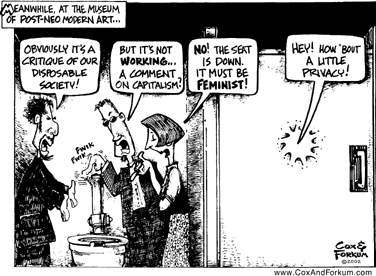
FORKUM: Yes, I highly recommend the book -- all of Ayn Rand's books are worth reading. The Romantic Manifesto is an excellent, philosophical analysis of art, from television to novels to painting.
COX: The Romantic Manifesto was a fun read. It kind of gave me a beginning point to justify my "throwback" aesthetic. Instead of being an unimaginative hack, I could be a messenger bringing back the joy of Realism. I found her words to be very invigorating. Now I had something to say to all those stiff-necked modernists who prefer barbaric paint globs over humanist values.
EGO: John, for how many years have you been a painter of fine art? Who's your favorite artist?
COX: I've been showing my paintings for 10 years, and I hope to do it for the rest of my life. I consider my fine art goals to be the engine for my cartooning. A lot of the adrenaline rush I get from a sharp cartoon is found in the experience of selling a very personal painting. I've come to realize that my two loves are inseparable, and I want to pursue them both with equal passion.
Who are my painting heroes? Andrew Wyeth for his elegant use of the figure in large expanses of landscape. Edward Hopper for his sense of solitude in his work. He found a dignity in physical isolation that I find very romantic. Maxfield Parrish for his sense of design and his magical take on Realism. But for pure bravura and lust for the human experience, I'd have to say writer Ernest Hemingway's life is the most inspirational. Not his outrageous fame per se, or his shameless irresponsibility, but how he reveled in physical and intellectual pleasure. I really admire his sense of adventure and the courage to see it through. Although, I think I'll pass on the shotgun thing.
EGO: Allen, could you provide us with a gag cartoon from your magazine, Automotive Report? How about something on the topic "Amish versus Technology"?
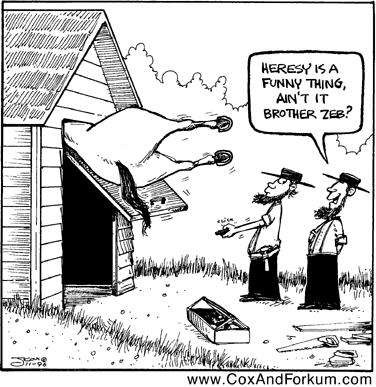
FORKUM: This cartoon is from 1996 and, if I remember correctly, it was entirely John's idea.
COX: Yeah... the Amish thing. Loaded with paradoxes that lead to some really funny ideas. Granted, the cartoon was also skirting the meaning of progress, but when I hit upon the idea of a horse crunched in a garage door, it became pure slapstick. The cartoon represents my tendency to make fun of religious dogma... and dumbfounded farm animals.
EGO: What are your plans for the future? When could we purchase your next book? Another Cox & Forkum product?
FORKUM: We're still striving for syndication. We recently sent out submissions and are waiting for reactions. In the mean time, we're producing cartoons as if we're syndicated. Publishing a second book is a strong possibility, perhaps sometime next year. But first we want to sell more copies of "Black & White World." I have too many stored in my garage! We'll likely add more t-shirts to our line. And we're considering selling some of our original artwork.
COX: Ultimately, I'd love to see our work in a big gallery show. Think of a nice airy room with cream walls and hundreds of original drawings all matted and glassed. Bottles of cabernets and pinot grigio piled near a bandstand oozing delicious jazz music across the room. Kind of a celebration of art and ideas. Until then, though, I'm thrilled with the possibilities of where the drawings can lead us. I tell everyone, You ain't seen nothing yet.
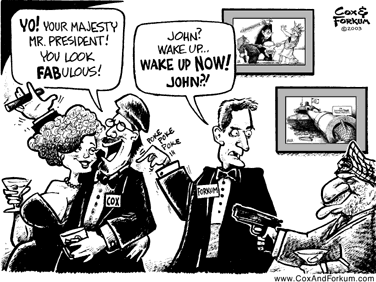
For more cartoons like this, check out John Cox & Allen Forkum's book, Black & White World.

No comments:
Post a Comment